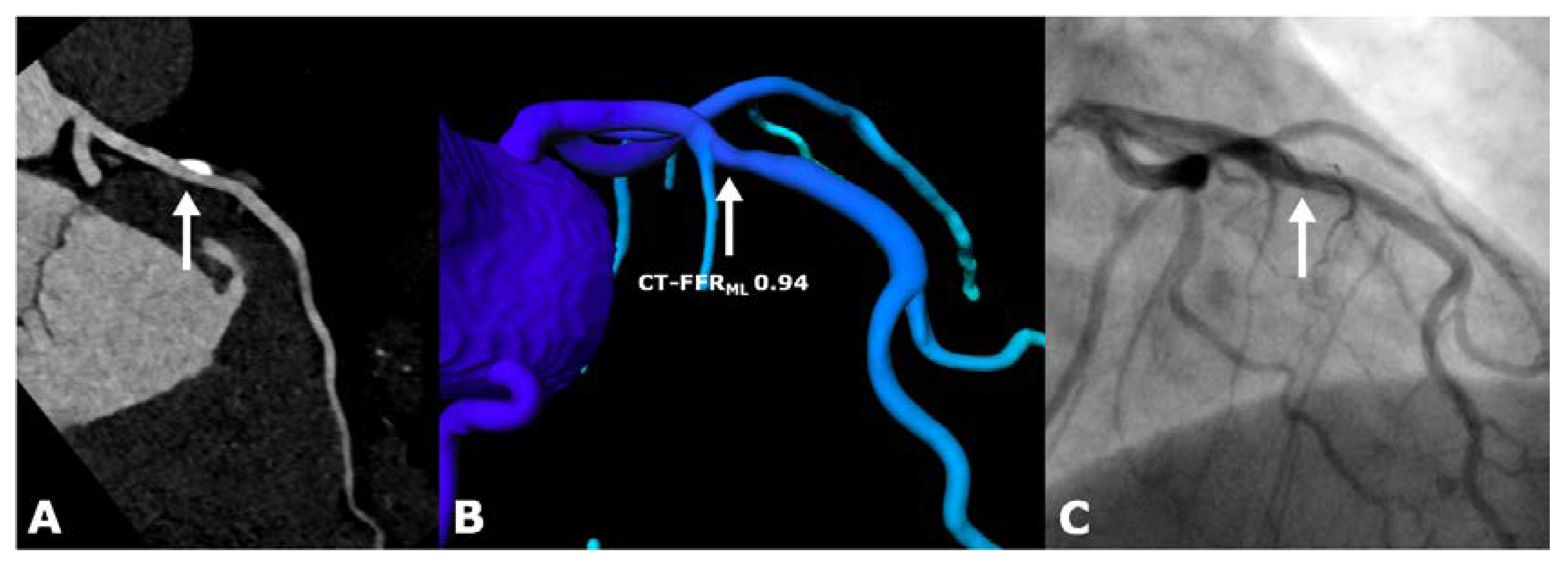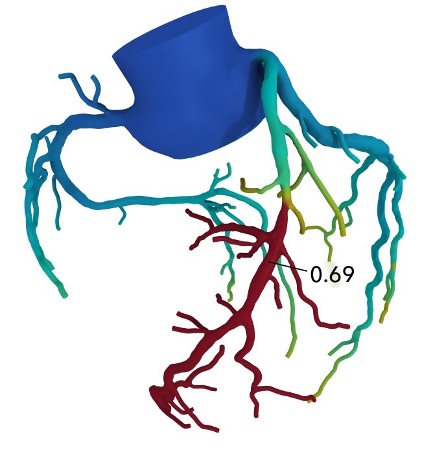fractional flow reserve ct
The CTFFR test makes it possible to reduce the need for invasive procedures and reach a confident decision about a heart condition and appropriate treatment. The process involves constructing a digital model of coronary anatomy and calculating FFR across the entire vascular tree using computational fluid dynamics.
Ffr Ct Is Ready For Prime Time Evaluation Of Coronary Disease Daic
Fractional Flow Reserve Derived From CT Related Treatment The safety and scientific validity of this study is the responsibility of the study sponsor and investigators.

. HeartFlow requires patient data transfer offsite to be post-processed. Fractional flow reserve computed tomography FFR-CT is a relatively new technology that estimates the effect of coronary arterial narrowing on blood flow based upon the images acquired in a coronary computed tomography angiography study. The CT angiogram fractional flow reserve or CTFFR test is a non-invasive way to diagnose the underlying cause of chest pain.
HeartFlow technology uses computed tomography CT scans to calculate how much blood is flowing through the coronary arteries. Fractional Flow Reserve Computed Tomography FFR-CT is a noninvasive technology developed by HeartFlow Inc. Its role is to provide information that can more appropriately select patients requiring invasive coronary.
FFR is defined as a ratio of the maximal myocardial blood flow in the presence of a stenosis to the theoretical normal maximal flow in the same distribution. Its diagnostic performance has been established against invasive fractional flow reserve in multi-centre trials and a growing body of evidence has demonstrated its utility in predicting clinical outcomes. Recent advances in image-based modeling and computational fluid dynamics permit the calculation of coronary artery pressure and flow from typically acquired coronary computed tomography CT scans.
Fractional flow reserve is defined as the pressure after distal. Fractional flow reserve derived from coronary computed tomography enables anatomical and haemodynamic assessment of coronary artery disease in a single non-invasive test. The process involves constructing a digital model of coronary anatomy and calculating FFR across the.
Listing a study does not mean it has been evaluated by the US. It is defined as the ratio of maximal flow achievable in the stenotic coronary artery to the maximal flow achievable in the same coronary artery if it was normal 1. Fractional Flow Reserve FFR can be modeled noninvasively using images obtained during Coronary Computed Tomography Angiography CCTA.
Fractional flow reserve FFR derived from data obtained during the computed tomography coronary angiogram provides critical information to the cardiology medical team without exposing the patient to unnecessary risk. Data preparation and transmission analysis of fluid dynamics and simulated maximal coronary. Coronary Stenosis For CAD Coronary Artery Disease Diagnosis.
The University of Chicago Medicine is one of a few hospitals using fractional flow reserve derived from CT FFRCT a new advanced technology that provides detailed information about your heart and how blood flows through your arteries. Noninvasive estimated coronary fractional flow reserve ffr derived from coronary computed tomography angiography data using computation fluid dynamics physiologic simulation software analysis of functional data to assess the severity of coronary artery disease. CCTA coronary CT angiography FFR fractional flow reserve LAD left anterior descending artery MBF myocardial blood flow MPI myocardial perfusion imaging.
To evaluate lesion-specific ischemia FFR CT is measured 2 cm distal to a stenotic lesion. CT fractional flow reserve FFR CT is a physiologic simulation technique that models coronary flow from routine coronary CT angiography CTA. Computed fractional flow reserve is the ratio of mean coronary artery pressure divided by mean aortic pressure under conditions of simulated.
Previously FFR data was acquired by subjecting the patient to an invasive cardiac catheterisation. Our portfolio has the right solution for every patient with coronary artery disease. FFRCT identifies exactly where low blood flow exists and indicates how severe the blockage may be.
From catheter-based Fractional Flow Reserve FFR assessment to image-based Angio-FFR 3 and noninvasive CT FFR. Accurately measure pressure differences across a stenosis confidently assess its hemodynamic significance and make confident decisions for all patients. Fractional flow reserve w cardiac CT angiography technique is a non-invasive treatment for coronary artery disease.
Fractional flow reserve has become the gold standard method for assessing. Open in a separate window. To test for coronary artery disease.
This test helps to identify whether patients have coronary artery disease before. Fractional flow reserve derived from coronary CT angiography FFR CT is an emerging tool for noninvasive evaluation of coronary artery disease that provides a combined anatomic and physiologic evaluation. Fractional Flow Reserve Computed Tomography FFR-CT is a noninvasive technology developed by HeartFlow Inc.
MBF derived from dynamic CT-MPI revealing the absence of decreased myocardial perfusion of LAD territory. FFR CT greater than 08 is normal 07608 is borderline and 075 or less is abnormal. We carried out a meta-analysis to derive reliable assessment of the diagnostic performances of FFR CT and compare the diagnostic accuracy with CCTA using FFR as reference.
A post-processing technique named fractional flow reserve FFR by coronary CTA or FFR CT has been developed by HeartFlow Redwood City CA which uses computational fluid dynamics applied to a standard CCTA dataset to provide FFR CT data on all major epicardial vessels. Fractional Flow Reserve Computed Tomography The Cardiovascular Imaging Core Laboratory was a partner in the NXT Trial that lead to Food and Drug Administration approval of HeartFlow fractional flow reserve computed tomography FFR-CT analysis the first of its kind. Fractional flow reserve derived from CT angiography FFR CT is one potential solution to the issue of low specificity and the lack of functional assessment at CT angiography.
Fractional flow reserve FFR is an invasive measurement developed in 1990s for evaluation of functional significance of stenoses in the epicardial coronary artery. Fractional flow reserve FFR is a technique to evaluate the hemodynamic relevance of coronary artery stenoses 12. A method named computed tomography angiography-derived fractional flow reserve FFR CT is an alternative method for detecting hemodynamically significant coronary stenosis.

Ct Fractional Flow Reserve A Practical Guide To Application Interpretation And Problem Solving Radiographics

Ffr Ct Is Ready For Prime Time Evaluation Of Coronary Disease Daic

Example Of Ct Derived Fractional Flow Reserve Ffrct In Clinical Download Scientific Diagram

Coronary Ct Angiography Derived Fractional Flow Reserve Semantic Scholar

Noninvasive Fractional Flow Reserve Derived From Coronary Ct Angiography Cta Tctmd Com
Process Of Computational Fractional Flow Reserve Ffr Calculation A Download Scientific Diagram
The Evolving Story Of Fractional Flow Reserve Ct Cardiac Interventions Today

Ct Derived Fractional Flow Reserve Ct Ffr In The Evaluation Of Coronary Artery Disease Heart Lung And Circulation

Fractional Flow Reserve Coronary Cta Youtube

Jcm Free Full Text Additional Value Of Machine Learning Computed Tomographic Angiography Based Fractional Flow Reserve Compared To Standard Computed Tomographic Angiography Html

Non Invasive Ffr Ct Reduces Invasive Tests In Chest Pain Patients Daic

Ct Coronary Artery Fractional Flow Reserve Analysis Arrives At Duke Duke University Department Of Radiology

Uh Case Medical Center First To Offer Novel Heartflow Ct Ffr Technology Daic

Heartflow Ffrct For Estimating Fractional Flow Reserve Ffr From Coronary Ct Angiography Health Innovation Network

Fractional Flow Reserve Ct In A 61 Year Old Male With Typical Angina Download Scientific Diagram

Computed Tomography Ct Derived Fractional Flow Reserve Ffr Imaging Download Scientific Diagram

Fractional Flow Reserve Ct In A 61 Year Old Male With Typical Angina Download Scientific Diagram

Example Of Ct Derived Fractional Flow Reserve Ffrct In Clinical Download Scientific Diagram
Ffr Ct Did Not Significantly Reduce Costs But Reduced Rates Of Invasive Coronary Angiography Daic